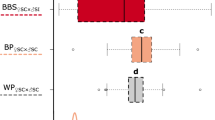Abstract
Self-incompatibility is a genetically controlled mechanism which prevents inbreeding in plants (de Nettancourt, 1977). In many, but not all cases, it is controlled by a multi-allelic, single gene, the S-gene. The system operates to enhance outcrossing and to ensure that a plant is fertilized by a genetically distinct individual of the same species. There are two major types of self-incompatibility. The most widespread is gametophytic self-incompatibility which involves interaction of a product of the haploid genome of the male gametophyte (carried within the pollen grain) and a product of the diploid genome of the female tissue of the sporophyte, the pistil. In incompatible matings, as is the case when the S-allele carried by the haploid pollen matches either of the S-alleles present in the diploid style, pollen tube growth is arrested within the transmitting tract (Figure 1).
Access this chapter
Tax calculation will be finalised at checkout
Purchases are for personal use only
Preview
Unable to display preview. Download preview PDF.
Similar content being viewed by others
References
Ai, y., Singh, A., Coleman, CE., loerger, TR., Kheyr-Pour, A. and Kao, T-H. Self-incompatibility in Petunia inflata: Isolation and characterization of cDNAs encoding three S-allele-associated proteins. Sex. Plant Reprod. 3: 130 – 138; 1990.
Anderson, MA., Hoggart, RD. and Clarke, AE. The possible role of lectins in mediating plant cell–ceil interactions. In: Chemical taxonomy, molecular biology and function of plant lectins. New York, Alan R. Liss Inc.; 1983: p143 – 161.
Anderson, MA., Cornish, EC., Mau, S-L, Williams, EG., Hoggart, R., Atkinson, A., Bunig, V., Grego, B., Simpson, R., Roche, PJ., Haley, JD., Penschow, JD., Niall, HD., Tregear, GW., Coghlan, JP., Crawford, RJ. and Clarke, AE. Cloning of cDNA for a stylar glycoprotein associated with expression of self-incompatibility in Nicotiana alata. Nature 321: 38 – 44; 1986.
Anderson, MA., McFadden, GI., Bernatzky, R., Atkinson, A., Orpin, T., Dedman, H.,Tregear, G., Fernley, R. and Clarke, AE. Sequence variability of three alleles of the self-incompatibility gene of Nicotiana alata. The Rant Cell 1: 483 – 491; 1989.
Cornish, ec., Anderson, ma. and Clarke, ae. Molecular aspects of fertilization in flowering plants. Annual Review Cell Biology, 4: 209 – 228; 1988.
D’Alessio, G., Di Donato, A. Parente A. and Piccoli, R. Seminal RNase; a unique member of the ribonucleases superfamily. TIBS 16: 104 – 106; 1991.
p.Ebert, PR., Anderson, MA., Bernatzky, R., Altschuler, M. and Clarke AE. Genetic polymorphism of self-incompatibility in flowering plants. Cell 56:255–262; 1989.
Franklin-Tong, ve., Ruuth e., marmey, p., lawrence, mj. and franklin, rch. New Phytol. 112: 307; 1989
Gray, je., Mcclure, ba., Haring, V., anderson, ma. and Clarke, ae. Self-incompatibility as a model for cell-cell recognition in flowering plants. In: Herrmann, RG., ed. Plant Molecular Biology. New York: Plenum Publishing Co.; 1990.
Gray, je., Mcclure, ba., blinig, i., anderson, ma. and Clarke, ae. Action of the style product of the self-incompatibility gene of Nicotiana alata (S-RNase) on in vitro grown pollen tubes. The Plant Cell 3: 271 – 283; 1991.
Haring, V., McClure, BA. and Clarke, AE. Molecular aspects of self-incompatibility in the Solanaceae. In: Dennis, ES. and Uewllyn, D., eds. Advances in Plant Gene Research. Vol 7. Vienna, Springer-Verlag; 1991.
Haring,V., Gray, je., McClure, ba.,Anderson, MA. and Clarke, ae. Self-incompatibility: a self-recognition system in plants. Science 250: 937 – 941; 1990.
Kheyr-Pour, A., Bintrim, SB., loerger, TR., Remy, R. Hammond, SA. and Kao, T-H. Squence diversity of pistil S—proteins associated with gametophytic self-incompatibility in Nicotiana alata. Sex. Plant Reprod. 3: 88 – 97; 1990.
Lewis, D . Incompatibility in flowering plants. Biol. Rev. 24: 472 – 496; 1949.
Lewis, D. Genetic control of specificity and activity of the S-antigen in plants. Proc. Roy. Soc. Lond. [Biol.] 151: 468 – 477; 1960.
Mascarenhas, jp. The biochemistry of angiosperm pollen development. Bot. Rev., 41: 259 – 314; 1975.
McClure, BA., Haring, V., Ebert, PR., Anderson, MA., Simpson, RJ., Sakiyama, F. and Clarke, AE. Style self-incompatibility gene products of Nicotiana alata are ribonucieases. Nature 342: 955 – 957; 1989.
McClure, BA., Gray, JE., Anderson, MA. and Clarke, AE. Self-incompatibility in Nicotiana alata involves degradation of pollen rRNA. Nature 347: 757 – 760; 1990.
Nasrallah, jb. and Nasrallah, me. The molecular genetics of self-incompatibility in Brassica. Ann. Rev. Genet. 23: 121 – 139; 1989.
Reed Clark, K., Okuley, JJ., Collins, PD. and Sims, TL. (1990). Sequence variability and developmental expression of S-alleles in self-incompatible and pseudo-self-compatible Petunia. The Plant Cell 2: 815 – 826; 1990.
Takayama,S. Isogai, A., Tsukamoto, C., Ueda, Y., Hinata, K., Okazaki. and Suzuki, A. Sequences of S-glycoproteins, products of the Brassica campestris self-incompatibility locus. Nature 326: 102 – 105; 1987.
Xu, B., Mu, J., Nevins, DL, Grun, P. and Kao, T-H. Cloning and sequencing of cDNAs encoding two self-incompatibility associated proteins in Solanum chacoense. Molec. gen. Genet. 224: 341 – 346; 1990.
Editor information
Editors and Affiliations
Rights and permissions
Copyright information
© 1992 Springer-Verlag New York, Inc.
About this paper
Cite this paper
Mau, SL., Bacic, A., Murfett, J., McClure, B., Anderson, M., Clarke, A. (1992). Molecular Genetics of Self-incompatibility inNicotiana alata . In: Ottaviano, E., Gorla, M.S., Mulcahy, D.L., Mulcahy, G.B. (eds) Angiosperm Pollen and Ovules. Springer, New York, NY. https://doi.org/10.1007/978-1-4612-2958-2_12
Download citation
DOI: https://doi.org/10.1007/978-1-4612-2958-2_12
Publisher Name: Springer, New York, NY
Print ISBN: 978-1-4612-7733-0
Online ISBN: 978-1-4612-2958-2
eBook Packages: Springer Book Archive




